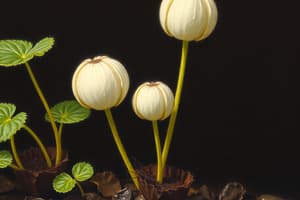Podcast
Questions and Answers
What is the primary function of seeds?
What is the primary function of seeds?
- To protect the soil from erosion
- To transport water
- To provide nourishment to animals
- To form new plants on germination (correct)
What are some ways that seeds are transported?
What are some ways that seeds are transported?
- Only by human intervention
- By animals, wind, and water (correct)
- Exclusively via insect activity
- Primarily through underground tunnels
Which condition is necessary for a seed to begin growing?
Which condition is necessary for a seed to begin growing?
- Exposure to sunlight only
- Absence of water
- A temperature below freezing
- Penetration of water and oxygen (correct)
What does a mature fertilized ovule form?
What does a mature fertilized ovule form?
What is a critical step in the germination process of seeds?
What is a critical step in the germination process of seeds?
What is the shape of the described object?
What is the shape of the described object?
What color is associated with the described object?
What color is associated with the described object?
What can be inferred about the odor of the object when it is intact?
What can be inferred about the odor of the object when it is intact?
How does the object smell when it is crushed?
How does the object smell when it is crushed?
What is the described taste of the object?
What is the described taste of the object?
What is the surface texture of the seed described?
What is the surface texture of the seed described?
What type of ovule is present in this seed?
What type of ovule is present in this seed?
What does the raphe of the ovule extend along?
What does the raphe of the ovule extend along?
What are the components of the testa in the seed?
What are the components of the testa in the seed?
What is the appearance of the raphe on the ovule?
What is the appearance of the raphe on the ovule?
Which layers make up the outer integument?
Which layers make up the outer integument?
Which of the following layers is NOT part of the inner integument?
Which of the following layers is NOT part of the inner integument?
What type of cells are found in the cross layer of the seed?
What type of cells are found in the cross layer of the seed?
Which of the following is a part of the embryo in a seed?
Which of the following is a part of the embryo in a seed?
What is the function of the scleride layer in the inner integument?
What is the function of the scleride layer in the inner integument?
What medicinal use does linseed have related to bowel health?
What medicinal use does linseed have related to bowel health?
How does linseed benefit those with type 2 diabetes?
How does linseed benefit those with type 2 diabetes?
Which of the following is NOT a medicinal use of linseed?
Which of the following is NOT a medicinal use of linseed?
Linseed increases bowel movements, which can be particularly helpful in managing what condition?
Linseed increases bowel movements, which can be particularly helpful in managing what condition?
What effect does linseed have on bowel movements?
What effect does linseed have on bowel movements?
Flashcards are hidden until you start studying
Study Notes
Seed Definition
- Seeds are mature fertilized ovules containing an embryo; these are responsible for forming new plants upon germination.
Seed Transport
- Seeds are transported by animals, wind, and water.
Seed Germination
- When favorable conditions exist, water and oxygen penetrate the seed coat and the embryo grows.
Macroscopical Seed Characteristics
- Shape: Elongated, ovate, flattened, rounded base, pointed apex.
- Color: Dark brown.
- Odour: Odourless when whole, oily when crushed.
- Taste: Mucilaginous, oily.
- Surface: Finely pitted, smooth, shiny testa (seed coat).
- Type of Ovule: Anatropous ovule (Raphe extended half the seed circumference as a yellow shiny line).
Seed Transverse Section
- Testa: Outer and inner integuments.
- Outer integument: Forms the epidermis and hypodermis.
- Inner integument: Forms the scleride layer, hyaline layer, and pigment layer.
- Endosperm: Contains nutrients for the developing embryo.
- Embryo: Young plant inside the seed containing radicle (root), plumule (shoot), and cotyledons (seed leaves).
Cross Layer in Seed
- Contains fragments of elongated, lignified sclerenchymatous cells.
- These cells are crossed by thin-walled elongated cells on one side and rounded, thick-walled cells on the other side.
Medicinal Uses of Linseed
- Constipation: Increases bowel movements.
- Type 2 Diabetes: Slightly improves blood sugar control.
Studying That Suits You
Use AI to generate personalized quizzes and flashcards to suit your learning preferences.




